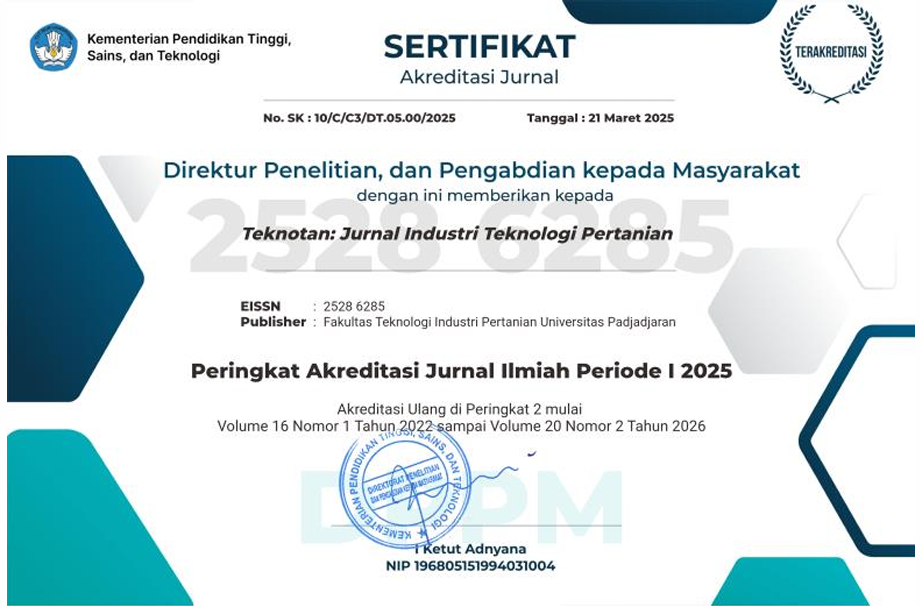Development of Antimicrobial Edible Film Enriched with Double Emulsion of Cinnamon (Cinnamomum burmannii) Essential Oil
Abstract
The edible film can be used as a carrier of bioactive compounds that contributed to the shelf life or nutritional benefit of food products; however, the addition of bioactive compounds relied greatly on the compatibility of the bioactive compound toward the edible film matrix. Most of the bioactive compounds are nonpolar which incompatible with the polar nature of the edible film. In this research, the nonpolar essential oil of cinnamon, a potent antimicrobial agent, was made into a double emulsion. The double emulsions were made through a two steps emulsification stages, with CaCl2 as the inner water phase and guar gum as the outer water phase. The physicochemical characteristics (stability, viscosity, and droplet size) and the antimicrobial activity of the double emulsion were observed. The double emulsion showed stability up to 7 days of storage at room temperature with high antimicrobial activity; MBC values of 0.86, 1.37, 0.31, and 0.51 mg/mL against E. coli, S. aureus, R. stolonifera, and A. niger, respectively. Different concentrations (5%,10%,15%) of both emulsions were added into edible film suspension. The formation of double emulsion showed a promising result as a means to incorporate nonpolar compounds into basic edible film formulation to increase its functional properties while retaining their physicochemical characteristic. All formulations showed good edible film characteristics, with edible film with 8% essential oil showing a high inhibition zone (15.81 dan 6.92 mm) toward E. Coli and R. stolonifer, 0.0052 mm thickness, the tensile strength of 6.32 MPa, 13% elongation and WVTR of 1.06 g/cm2.h.
Keywords
Full Text:
PDFReferences
Bahram, S., Rezaei, M., Soltani, M., Kamali, A., Ojagh, S. M., & Abdollahi, M. (2014). Whey Protein Concentrate Edible Film Activated with Cinnamon Essential Oil. Journal of Food Processing and Preservation, 38(3), 1251–1258. https://doi.org/https://doi.org/10.1111/jfpp.12086
Dibazar, S. P., Fateh, S., & Daneshmandi, S. (2015). Immunomodulatory effects of clove (Syzygium aromaticum) constituents on macrophages: in vitro evaluations of aqueous and ethanolic components. Journal of Immunotoxicology, 12(2), 124–131. https://doi.org/10.3109/1547691X.2014.912698
Ding, S., Serra, C. A., Vandamme, T. F., Yu, W., & Anton, N. (2019). Double emulsions prepared by two-step emulsification: History, state-of-the-art, and perspective. Journal of Controlled Release, 295, 31–49. https://doi.org/https://doi.org/10.1016/j.jconrel.2018.12.037
El Atki, Y., Aouam, I., El Kamari, F., Taroq, A., Nayme, K., Timinouni, M., Lyoussi, B., & Abdellaoui, A. (2019). Antibacterial activity of cinnamon essential oils and their synergistic potential with antibiotics. Journal of Advanced Pharmaceutical Technology & Research, 10(2), 63–67. https://doi.org/10.4103/japtr.JAPTR_366_18
Galus, S., & Kadzińska, J. (2016). Moisture Sensitivity, Optical, Mechanical and Structural Properties of Whey Protein-Based Edible Films Incorporated with Rapeseed Oil. Food Technology and Biotechnology, 54(1), 78–89. https://doi.org/10.17113/ftb.54.01.16.3889
Ghannam, M. T. (2005). Water-in-Crude Oil Emulsion Stability Investigation. Petroleum Science and Technology, 23(5–6), 649–667. https://doi.org/10.1081/LFT-200033001
Ghasemi, H., Darjani, S., Mazloomi, H., & Mozaffari, S. (2020). Preparation of stable multiple emulsions using food-grade emulsifiers: evaluating the effects of emulsifier concentration, W/O phase ratio, and emulsification process. SN Applied Sciences, 2(12), 2002. https://doi.org/10.1007/s42452-020-03879-5
Khumpirapang, N., Klayraung, S., Tima, S., & Okonogi, S. (2021). Development of Microemulsion Containing Alpinia galanga Oil and Its Major Compounds: Enhancement of Antimicrobial Activities. In Pharmaceutics (Vol. 13, Issue 2). https://doi.org/10.3390/pharmaceutics13020265
Li, Y., Nie, Y.-Y., Zhou, L., Li, S., Tang, X., Ding, Y., & Li, S. (2014). The possible mechanism of antifungal activity of cinnamon oil against Rhizopus nigricans.
Liu, Q., Meng, X., Li, Y., Zhao, C.-N., Tang, G.-Y., & Li, H.-B. (2017). Antibacterial and Antifungal Activities of Spices. International Journal of Molecular Sciences, 18(6), 1283. https://doi.org/10.3390/ijms18061283
Lixandru, B.-E., Drăcea, N. O., Dragomirescu, C. C., Drăgulescu, E. C., Coldea, I. L., Anton, L., Dobre, E., Rovinaru, C., & Codiţă, I. (2010). Antimicrobial activity of plant essential oils against bacterial and fungal species involved in food poisoning and/or food decay. Roumanian Archives of Microbiology and Immunology, 69(4), 224–230.
Mudgil, D., Barak, S., & Khatkar, B. S. (2014). Guar gum: processing, properties and food applications-A Review. Journal of Food Science and Technology, 51(3), 409–418. https://doi.org/10.1007/s13197-011-0522-x
Nabavi, S. F., Di Lorenzo, A., Izadi, M., Sobarzo-Sánchez, E., Daglia, M., & Nabavi, S. M. (2015). Antibacterial Effects of Cinnamon: From Farm to Food, Cosmetic and Pharmaceutical Industries. Nutrients, 7(9), 7729–7748. https://doi.org/10.3390/nu7095359
Niknam, S. M., Escudero, I., & Benito, J. M. (2020). Formulation and preparation of water-in-oil-in-water emulsions loaded with a phenolic-rich inner aqueous phase by application of high-energy emulsification methods. Foods, 9(10), 13–28. https://doi.org/10.3390/foods9101411
Noshirvani, N., Ghanbarzadeh, B., Gardrat, C., Rezaei, M. R., Hashemi, M., Le Coz, C., & Coma, V. (2017). Cinnamon and ginger essential oils to improve antifungal, physical, and mechanical properties of chitosan-carboxymethyl cellulose films. Food Hydrocolloids, 70, 36–45. https://doi.org/https://doi.org/10.1016/j.foodhyd.2017.03.015
Nurindra, A., Alamsjah, M., & Sudarno, S. (2019). Karakterisasi Edible Film dari Pati Propagul Mangrove Lindur (Bruguiera gymnorrhiza) dengan Penambahan Carboxymethyl Cellulose (Cmc) sebagai Pemlastis [Characterization of Edible Film From Propagules Mangrove Lindur (Bruguiera Gymnorrhiza) Starch with Add. Jurnal Ilmiah Perikanan Dan Kelautan, 7, 125. https://doi.org/10.20473/jipk.v7i2.11195
Oprea, S. (2013). Effects of guar gum content on structure and properties of multi-crosslinked polyurethane composite films. Composites Part B: Engineering, 44(1), 76–83. https://doi.org/https://doi.org/10.1016/j.compositesb.2012.07.018
Paula, D. de A., de Oliveira, E. B., de Carvalho Teixeira, A. V. N., Soares, A. de S., & Ramos, A. M. (2018). Double emulsions (W/O/W): physical characteristics and perceived intensity of salty taste. International Journal of Food Science & Technology, 53(2), 475–483. https://doi.org/https://doi.org/10.1111/ijfs.13606
Saberi, B., Thakur, R., Bhuyan, D. J., Vuong, Q. Van, Chockchaisawasdee, S., Golding, J. B., Scarlett, C. J., & Stathopoulos, C. (2017). Development of edible blend films with good mechanical and barrier properties from pea starch and guar gum. Starch-Starke, 69, 1600227.
Sanla-Ead, N., Jangchud, A., Chonhenchob, V., & Suppakul, P. (2012). Antimicrobial Activity of Cinnamaldehyde and Eugenol and Their Activity after Incorporation into Cellulose_based Packaging Films. Packaging Technology and Science, 25, 7–17.
Šuput, D., Lazić, V., Pezo, L., Markov, S., Vaštag, Ž., Popović, L., Radulović, A., Ostojić, S., Zlatanović, S., & Popović, S. (2016). Characterization of Starch Edible Films with Different Essential Oils Addition. Polish Journal of Food and Nutrition Sciences, 66(4), 277–285. https://doi.org/10.1515/pjfns-2016-0008
Tarek, N., Hassan, H. M., AbdelGhani, S. M. M., Radwan, I. A., Hammouda, O., & El-Gendy, A. O. (2014). Comparative chemical and antimicrobial study of nine essential oils obtained from medicinal plants growing in Egypt. Beni-Suef University Journal of Basic and Applied Sciences, 3(2), 149–156. https://doi.org/https://doi.org/10.1016/j.bjbas.2014.05.009
Tekin Pulatsü, E., Sahin, S., & Sumnu, G. (2018). Characterization of different double-emulsion formulations based on food-grade emulsifiers and stabilizers. Journal of Dispersion Science and Technology, 39(7), 996–1002. https://doi.org/10.1080/01932691.2017.1379021
Terjung, N., Löffler, M., Gibis, M., Hinrichs, J., & Weiss, J. (2012). Influence of droplet size on the efficacy of oil-in-water emulsions loaded with phenolic antimicrobials. Food & Function, 3(3), 290–301. https://doi.org/10.1039/C2FO10198J
Wong, Y. C., Ahmad-Mudzaqqir, M. Y., & Wan-Nurdiyana, W. A. (2014). Extraction of Essential Oil from Cinnamon (Cinnamomum Zeylanicum). Oriental Journal of Chemistry, 30, 37–47.
Yildirim, M., Sumnu, G., & Sahin, S. (2017). The effects of emulsifier type, phase ratio, and homogenization methods on the stability of the double emulsion. Journal of Dispersion Science and Technology, 38(6), 807–814. https://doi.org/10.1080/01932691.2016.1201768
DOI: https://doi.org/10.24198/jt.vol16n1.10
Refbacks
- There are currently no refbacks.
Indexed by:

This work is licensed under a Creative Commons Attribution 4.0 International License (CC BY-SA 4.0)


1.png)
.png)







